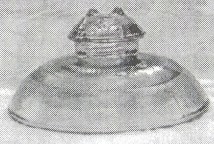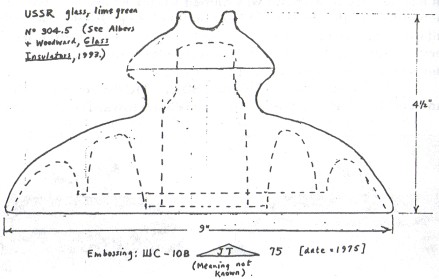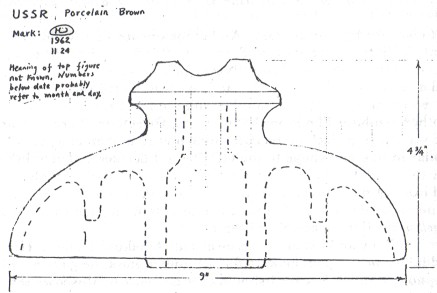Russian Insulator Report, 1994
by Donald M. Fiene
Reprinted from "Crown Jewels of the Wire", November 1994, page 15
Against all odds, I managed to squeeze in one last trip to Russia before I
retire in 1995. I gave a number of lectures on icons at a seminar in Moscow from
June 11 through June 26. All my expenses were paid, plus I got a big check
besides. It was basically the National Endowment for the Humanities that
financed it, so you might want to write to your congressman and see if he (or
she) thinks your tax dollars are going in the right direction.
The Russians are
in a bad way. Inflation has increased so rapidly that all of their coins are
worthless. Only the highest value coin -- the 300 rouble -- may be said to have any
value at 14 cents. Meanwhile, paper hardly does any better. During the time I
was in Moscow, it took 2100 roubles to buy what a dollar buys. Ten years ago the
rouble and the dollar were officially equal. In those days the highest paper
note was 100 roubles. Today it is 50,000 roubles -- and that amount buys only about
$25 worth of stuff. Everybody's pockets are full of worthless colorful paper.
Subway tokens -- made of plastic -- had been set very low (100 roubles), but two days
before I left the price jumped to 150 roubles -- reflecting another major
inflationary rise throughout the country. The food at our hotel was not too bad,
except that we were served liver at least three times a week. Bad scene! It was
depressing watching the Russians suffer. I was glad to leave for that reason. I
should mention also that the temperature was in the forties almost every
morning. You could see your breath some days.
As far as insulators are
concerned, I did manage to find three good ones. To put these in a proper
context, see my last two articles on Russian insulators in Crown Jewels of the Wire of November, 1989,
and December, 1992. The latter article indicates that on my return to Russia I
would search for a nine inch diameter, three-skirt glass power insulator, of amber
color -- visible overhead on the electric commuter-train power poles, but
nowhere else. These insulators were located on the lines going west from the
Kiev train station. I later noted that this glass type was listed in Glass
Insulators from Outside North America, Second Revision, by Marilyn Albers
and N. R. Woodward, 1993, with a CD number of 304.5. (I believe only one
example, damaged, and in a lime-green color, was known to the authors.) This
insulator is of interest for its size: no other three-skirt insulator in
this style, glass or porcelain -- has a diameter so great.
I had learned in 1992 that the third and fifth stations on the "elektrichka" (Ochakovo
and Solnechnaia) had "energy sections:' or energo-uchastki associated with
them -- that is, electrical substations, racks of telephone poles, piles of
discarded insulators, huge bins of new "isoliatory," and so on. As
soon as I got settled in Moscow in 1994 I took a little trip on the suburban
train, but not without difficulty. There were dozens of tracks going west, with
trains pulling out continually. I had trouble reading the timetables and was
never really certain where all these trains were going. In response to my
queries I would get a dozen different answers. And the trains were hideously
crowded -- like those in India in the 1940's. Still, they were cheap -- about 50 cents
for the first 20 miles. (One of the last vestiges of socialism.) Finally I
leaped onto a platform just as the train was pulling out. My fellow travelers
assured me that the train stopped at Solnechnaia -- the station I had decided to
investigate first.
Because of all my fooling around, I did not arrive at
Solnechnaia until almost quitting time. I had to climb over two walls to reach
the uchastok just as all the workers were leaving. But one stopped to listen to
me. He liked the pictures of my collection that I showed him. He unlocked the
door and offered me a seat. He said Solnechnaia, where he worked, was no good --
no
glass insulators at all. He quickly called two other sections, making contact
just before the last person had left for home. "The best place for
you," he said, "is Vnukovo. They're loaded." He drew me a map and
wrote down a couple of phone numbers. I thanked him and took the next train
back to the city.
A week later I had a free morning. I took the elektrichka to
Vnukovo (two stops past Solnechnaia) and tracked down Uchastok No.9. I asked to
see the boss. The latter turned out to be a nice old guy who had just retired at
age 66 and kept on coming in to work because he had nothing better to do.
Meanwhile, I myself was a harmless old geezer who would retire within a year at age 65. My
new friend was named Viktor Kharikov -- who had actually been the director of
Section 9 before retiring. We walked all over his territory looking for amber
glass power insulators -- and never found the first one. There were plenty of heavy
brown porcelain types, but I was not interested in those.
 |
 |
|
CD 304.5, light green and nine inch diameter brown porcelain |
So we returned to
Viktor's office. He did some telephoning and decided that Ochakovo, four stops
back toward town, was the best place for big power glass. And to make sure I got what I wanted, Viktor
came along with me. By this time I had little hope of getting the amber
insulator. Nevertheless, Viktor was able to find a replica of it in green. It
had been lying in the tall grass at one end of the yard, was in mint condition,
and there was not another insulator like it on the premises, Or rather, there
was just one --- a brown porcelain insulator nine inches in diameter, very similar
in size and shape to the CD 304.5. I decided to keep this. The third insulator I
decided to keep was a combination of glass and iron, rather heavy. It turned out
to be very similar to one I found in Armenia in 1985. (See the illustration on
page 14 of Crown Jewels of the Wire, December 1985.)
Viktor and I said our
farewells at Ochakova station. He said he would keep on looking for the amber
glass; he gave me his telephone number in case I should ever get back to Moscow:
280-7814. He also wrote me a note authorizing me to possess three secondhand
glass objects. That was for customs.
As it turned out, the note came in handy.
The customs official, as soon as he saw my glass and iron on his radar screen,
immediately demanded that I open my suitcase. "What are these?" he
wanted to know. "Isoliatory," I said. "What???" he said. But
I showed him the note and I flashed through the photos of my collection.
"Now I understand," he said. He was all smiles. He waved me through.


So I did it again. This visit to Russia was my thirteenth -- no less lucky than
the others. I'm only sorry that I won't be going again. I have brought back well
over 100 insulators from the USSR since 1966, eight of which I have kept in my
collection.
|
